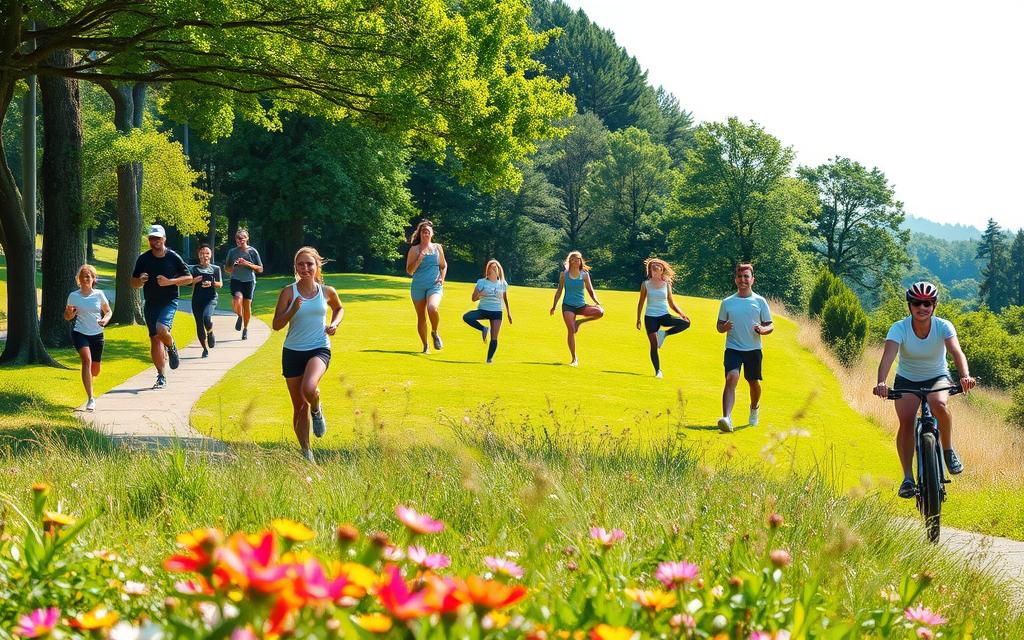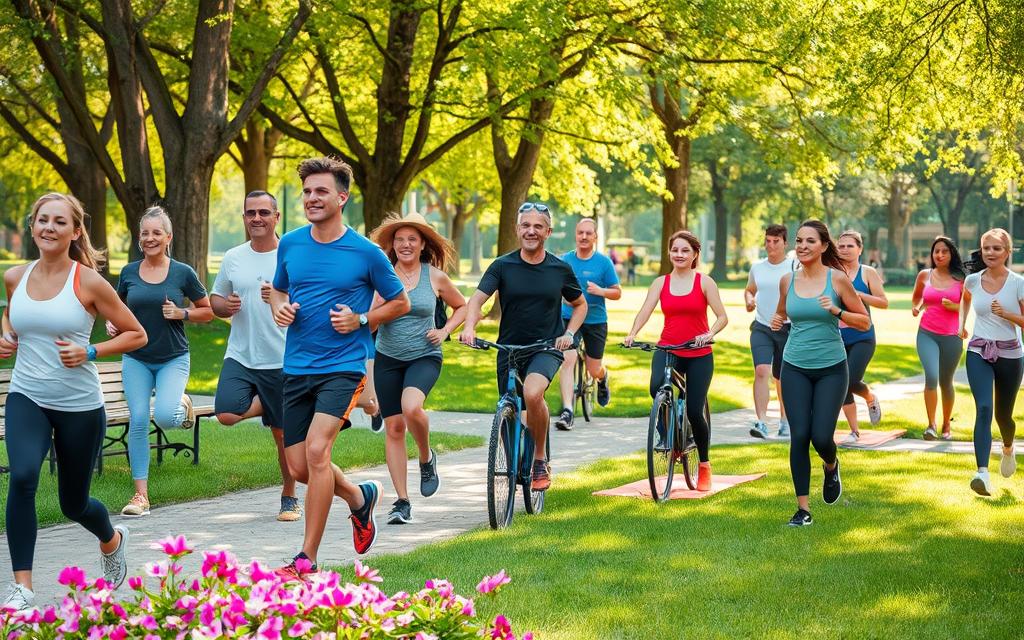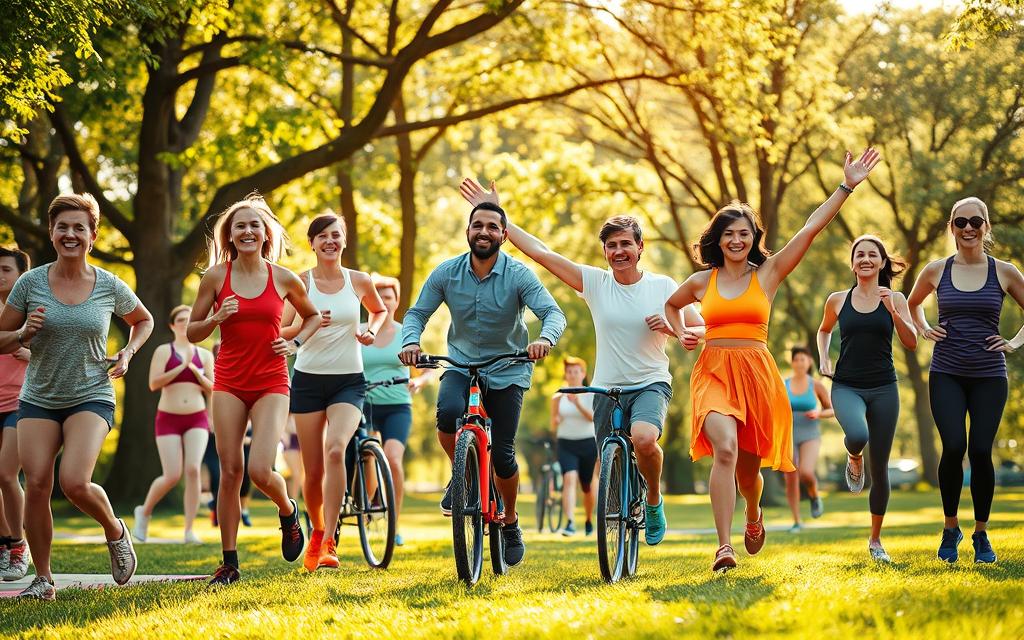Thinking about how exercise affects my immune system makes me realize its huge role in health. Studies show that regular exercise boosts our immune system, lowering the chance of getting sick1. The World Health Organization (WHO) says not moving enough is a big risk for death worldwide1. I find it interesting how exercise works with our immune cells and signals to keep us healthy. Knowing how exercise helps our immune system helps us make better health choices, which is why I’m eager to share this info.
Exercise is good for our immune system and helps us stay healthy2. Every year, infections like pneumonia kill about 3 million people2. Studies show that regular, moderate exercise can help us avoid getting sick more than sitting around1. As someone who knows how important exercise is, I think it’s key to talk about its health benefits.
Being active regularly can lower our risk of getting sick by 31%1. Doing physical activities 3–5 times a week for 30 minutes can boost our immune system1. Adding exercise to our daily lives can make our immune system stronger and help our body fight off sickness faster.
Key Takeaways
- Regular physical activity improves immune function and reduces the risk of illnesses and infections.
- Acute exercise is an immune system adjuvant that improves defense activity and metabolic health2.
- Regular moderate exercise reduces the risk of infection compared to a sedentary lifestyle1.
- Physical activity is associated with a 31% lower risk of infectious disease1.
- Incorporating physical activity into our daily routine can strengthen our immune system and enhance the speed of our body’s immune response.
- Regular physical activity can help reduce the risk of infectious diseases, including lower respiratory tract infections, which cause around 3 million deaths annually2.
Understanding the Connection Between Exercise and Immunity
Regular exercise boosts immune function, lowering the risk of getting sick3. It helps immune cells move better, making them more effective at fighting off germs3. Also, exercise reduces inflammation and enhances the immune response4.
Starting a fitness routine with moderate exercise can cut down on heart disease and colds, flu, and other illnesses4. It also helps clear out bacteria from the lungs and airways, lowering the risk of respiratory illnesses5. Some good examples of moderate exercise include:
- Bicycling with children a few times a week
- Engaging in daily walks lasting 20 to 30 minutes
- Attending the gym every other day
Remember, while exercise is great for immunity, it’s key to listen to your body. Too much effort can lead to a higher risk of getting sick after intense workouts3.
My Research Methodology and Study Parameters
To study how physical activity affects the immune system, I used a specific research method. I looked at how different exercises impact immune responses. The study focused on various exercises like cardio, strength training, and high-intensity interval training. It also examined how these exercises affect university students6.
The study aimed to understand how physical activity influences immune function. It also explored how exercise affects stress and academic performance6.
The research involved collecting data from university students. They had an average age of 22.49 ± 3.84 years and weighed about 73.94 ± 11.4 kg7. The study found that taking physical activity breaks improved stress and academic performance6.
It also showed that leisure-time physical activity positively affects stress and academic performance. However, it negatively impacts dysfunctional stress and recovery6.
This study provides valuable insights into the effects of physical activity on immune function. The results indicate that regular exercise can boost immune function and overall health6. These findings can help create exercise programs that improve immune function and reduce illness risk.

| Variable | Mean | SD |
|---|---|---|
| Age | 22.49 | 3.84 |
| Weight | 73.94 | 11.4 |
| VO2 max (LAPG) | 40.32 | 6.07 |
| VO2 max (HAPG) | 47.91 | 6.89 |
The study’s findings are crucial for creating exercise programs. They aim to enhance immune function and lower illness risk7.
How Different Types of Physical Activity Affect Immune Response
Regular physical activity is key for a strong immune system. Different exercises, like cardio, strength training, and high-intensity interval training, affect the immune system in different ways. For example, cardio exercises like running and cycling can boost immune function by lowering illness and infection risks8. Strength training also benefits the immune system, especially in older adults8.
High-intensity interval training can also enhance immune function, but the exact reasons are still being studied8. Studies also show that regular moderate exercise lowers infection risk more than a sedentary lifestyle9. But, very long or intense workouts can increase the risk of getting sick9.
Some important findings on physical activity and immune response include:
- Cardio exercises can improve immune function by reducing the risk of illnesses and infections8
- Strength training has a positive impact on immune function, particularly in older adults8
- High-intensity interval training can improve immune function, although the mechanisms are not fully understood8
- Regular moderate exercise reduces the risk of infection compared to a sedentary lifestyle9

In conclusion, various physical activities impact the immune system differently. While cardio and strength training can boost immune function, high-intensity interval training’s effects are more complex89. It’s vital to balance exercise with rest to keep the immune system healthy and avoid overtraining9.
Measuring the Benefits of an Active Lifestyle
Living an active lifestyle is key for good health and wellness. It can be measured by how much, how hard, and how often you exercise10. Regular exercise can cut the risk of eight cancers. Also, it could prevent 110,000 deaths yearly if more adults aged 40 and older exercised more10.
Some big benefits of an active lifestyle are:
- Lower risk of premature death
- Reduced risk of heart disease and stroke
- Improved fitness and overall health and wellness
- Increased energy levels
Doing at least 150 minutes of moderatephysical activity weekly can lower heart disease and stroke risk. More physical activity than 150 minutes a week can also reduce heart disease, stroke, type 2 diabetes, and metabolic syndrome risk10.
Studies show being fit or active can cut death risk by more than 50%. An extra 1000 kcal of physical activity per week can also lower mortality by about 20%11. Regular physical activity can also control blood sugar and lower heart disease and nerve damage risk for type 2 diabetes patients10.

Adding exercise to your daily life can greatly improve your health and wellness. It’s important to find fun activities that keep you motivated to stay active12.
| Benefits of Active Lifestyle | Reduced Risk of |
|---|---|
| Regular Exercise | Heart Disease and Stroke |
| Increased Physical Activity | Type 2 Diabetes and Metabolic Syndrome |
| Improved Fitness | Premature Death |
Duration and Intensity: Finding the Sweet Spot
Both duration and intensity are key in physical activity for health benefits. Research is ongoing to understand the best mix for immune function13. Studies show that moderate exercise is at 50% to 70% of maximum heart rate. Vigorous exercise is at 70% to 85% of maximum heart rate13.
For beginners, a 30-minute walk, three times a week, is a good start14. For those who run, 25 minutes at a heart rate of 120-125 bpm, two times a week, is recommended14. Finding the right balance is crucial for the best results.
The CDC reports that 10% of deaths in Americans aged 40-70 are linked to lack of exercise15. Adults should aim for 150 minutes of moderate exercise weekly for health15. The ideal daily steps are between 7,000-8,000 or 30-45 minutes of exercise most days15.

Finding a balance in duration and intensity is key for physical activity benefits14. This balance should be consistent in one’s lifestyle14. By doing so, individuals can lower their risk of death and improve health and well-being15.
Tracking Immune Markers Through Different Seasons
As the seasons change, it’s key to track immune markers. This helps us see how physical activity and exercise affect our immune health. The medical world is focused on finding and validating these markers16.
A good set of biomarkers should cover nutrition, metabolic health, and more. It should also include muscle status, endurance, injury risk, and inflammation16.
Our immune system changes with the seasons. Factors like temperature and sunlight play a role. Physical activity boosts our immune system, but we must track immune markers to avoid overdoing it.
A study showed elite soccer players’ immune systems were stressed during intense games17.
To track immune markers well, test at the start and end of big training periods16. Testing after a workout gives insight into immune response16. By monitoring immune markers across seasons, we learn how exercise affects our immune system. This helps us make choices that support our health.
Overcoming Exercise-Related Immune Suppression
Overtraining can weaken your immune system, making you more likely to get sick18. It’s important to know the signs of overtraining, like constant tiredness and trouble sleeping18. To fight this, rest well, stretch, and use foam rolling to recover19.
Eating right is also key to keeping your immune system strong. A diet full of protein, complex carbs, and healthy fats is best18. Drinking lots of water and avoiding sugary drinks also helps19.
Here are some effective recovery methods:
- Adequate rest and sleep
- Proper nutrition and hydration
- Stretching and foam rolling
- Active recovery techniques, such as yoga or light cardio
Using these methods can help you avoid immune suppression and keep your immune system strong18.
The Long-Term Effects of Consistent Physical Activity
Regular physical activity greatly improves our immune function. It leads to long-term health benefits. Exercise boosts our baseline immunity, lowering the chance of getting sick20. Adding physical activity to our daily life can greatly improve our immune function over time.
Research shows that long-term exercise enhances brain health and cognitive skills21. It also reduces the risk of serious diseases like heart disease, diabetes, and some cancers21. Making physical activity a part of our daily routine can significantly improve our health and wellbeing.
Some key benefits of regular exercise include:
- Improved baseline immunity
- Reduced risk of chronic diseases
- Improved cognitive performance and brain health
- Lower risk of premature mortality
By changing our lifestyle to include regular exercise, we can see lasting improvements in our immune function and overall health20. It’s important to remember that exercise has a big impact on our health. It’s never too late to start21.
Conclusion: Transforming Research into Practical Guidelines
My research clearly shows that physical activity boosts our immune system22. The right mix of workouts, like aerobic, strength training, and high-intensity intervals, makes a big difference22. It’s all about finding the perfect balance in how long and how hard you work out.
I strongly suggest making physical activity a big part of your life23. Try to do at least 150 minutes of moderate aerobic activity or 75 minutes of vigorous activity each week23. Also, make sure to do muscle-strengthening exercises two times a week23. This will help keep your immune system strong and lower your chances of getting sick.
Being consistent is crucial23. Add physical activity to your daily routine, like going for a walk, swimming, or doing strength training23. As you keep it up, you’ll notice how it improves your health and happiness. Let’s turn this research into real-life advice and make exercise a key part of our health journey.
FAQ
What is the impact of physical activity on immune function?
Regular exercise boosts the immune system, lowering the chance of getting sick. It works by improving how immune cells interact and by releasing important molecules.
How does the immune system work, and why is it important to study the connection between exercise and immunity?
The immune system protects us from infections and diseases. Exercise helps it work better, making us less likely to get sick. Knowing how exercise affects the immune system is key to staying healthy.
What was the research methodology and study parameters used to investigate the impact of physical activity on immune function?
The study looked at how different exercises affect the immune system. It included cardio, strength training, and high-intensity workouts. The findings show exercise’s positive effects on our health.
How do different types of physical activity affect immune response?
Cardio exercises like running boost the immune system. Strength training helps, especially in older adults. High-intensity workouts also improve immunity, though the reasons are still being studied.
How can the benefits of an active lifestyle be measured?
We can measure an active lifestyle by how much, how hard, and how often we exercise. Seeing these benefits helps us understand why regular exercise is so important.
What is the optimal duration and intensity of physical activity for immune function?
Longer and more intense workouts improve immunity more. But, finding the perfect balance is still a topic of research.
How does the impact of physical activity on immune function vary throughout the year?
Our immune function changes with the seasons. Tracking immune markers shows how important exercise is all year round.
How can exercise-related immune suppression be overcome?
Overtraining weakens the immune system, making us more susceptible to illness. Recognizing overtraining signs and using recovery strategies and nutrition can help maintain immune strength.
What are the long-term effects of consistent physical activity on immune function?
Regular exercise leads to lasting immune system improvements. Adding physical activity to our daily lives offers long-term health benefits, including better immunity.
Source Links
- Frontiers | Physical Activity and Nutritional Influence on Immune Function: An Important Strategy to Improve Immunity and Health Status – https://www.frontiersin.org/journals/physiology/articles/10.3389/fphys.2021.751374/full
- Editorial: The Effects of Physical Activity and Exercise on Immune Responses to Infection – https://pmc.ncbi.nlm.nih.gov/articles/PMC8892244/
- The compelling link between physical activity and the body’s defense system – https://pmc.ncbi.nlm.nih.gov/articles/PMC6523821/
- Exercise and immunity: MedlinePlus Medical Encyclopedia – https://medlineplus.gov/ency/article/007165.htm
- Exercise and immunity – UF Health – https://ufhealth.org/conditions-and-treatments/exercise-and-immunity
- Physical activity improves stress load, recovery, and academic performance-related parameters among university students: a longitudinal study on daily level – BMC Public Health – https://bmcpublichealth.biomedcentral.com/articles/10.1186/s12889-024-18082-z
- Relationship between Physical Fitness and Academic Performance in University Students – https://pmc.ncbi.nlm.nih.gov/articles/PMC9690464/
- The Relationships between Physical Activity, Exercise, and Sport on the Immune System – https://pmc.ncbi.nlm.nih.gov/articles/PMC9180823/
- Effects of Exercise on Immune Function – http://www.gssiweb.org/sports-science-exchange/article/sse-151-effects-of-exercise-on-immune-function
- Benefits of Physical Activity – https://www.cdc.gov/physical-activity-basics/benefits/index.html
- Health benefits of physical activity: the evidence – https://pmc.ncbi.nlm.nih.gov/articles/PMC1402378/
- A Practical Guide to Measuring Physical Activity – https://pmc.ncbi.nlm.nih.gov/articles/PMC3915355/
- How to Find the Exercise Intensity Sweet Spot – https://hemaware.org/mind-body/how-find-exercise-intensity-sweet-spot
- The Exercise Sweet Spot – https://medium.com/crows-feet/the-exercise-sweet-spot-38745d5c1bbb
- The Step Count “Sweet Spot” | Laura Cipullo – https://lauracipullo.com/blog/the-step-count-sweet-spot/
- Biomarkers in Sports and Exercise: Tracking Health, Performance, and Recovery in Athletes – https://pmc.ncbi.nlm.nih.gov/articles/PMC5640004/
- Immune inflammation markers and physical fitness during a congested match play period in elite male soccer players – Scientific Reports – https://www.nature.com/articles/s41598-024-81225-0
- Physical exercise as a tool to help the immune system against COVID-19: an integrative review of the current literature – https://pmc.ncbi.nlm.nih.gov/articles/PMC7387807/
- Debunking the Myth of Exercise-Induced Immune Suppression: Redefining the Impact of Exercise on Immunological Health Across the Lifespan – https://pmc.ncbi.nlm.nih.gov/articles/PMC5911985/
- Physical Activity, Fitness, and Physical Education: Effects on Academic Performance – Educating the Student Body – https://www.ncbi.nlm.nih.gov/books/NBK201501/
- Physical Activity and Physical Education: Relationship to Growth, Development, and Health – Educating the Student Body – https://www.ncbi.nlm.nih.gov/books/NBK201497/
- Evaluating the Science to Inform the Physical Activity Guidelines for Americans Midcourse Report – https://profpubs.com/index.php/jheal/article/view/55
- Physical activity: associations with health and summary of guidelines – https://pmc.ncbi.nlm.nih.gov/articles/PMC10335097/
